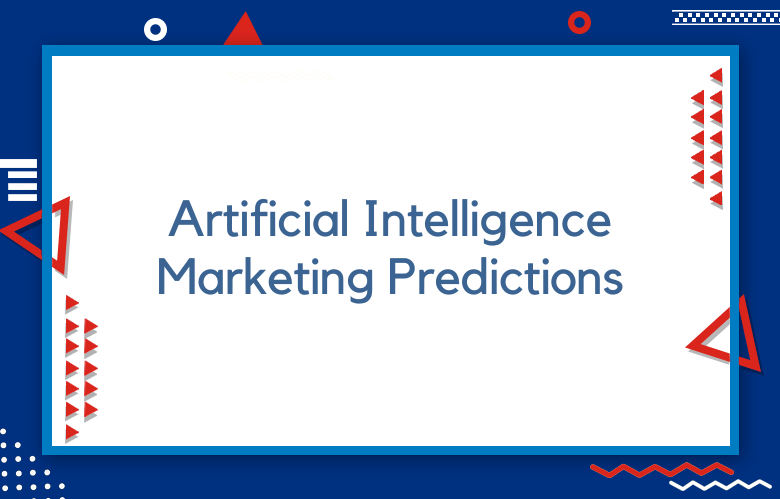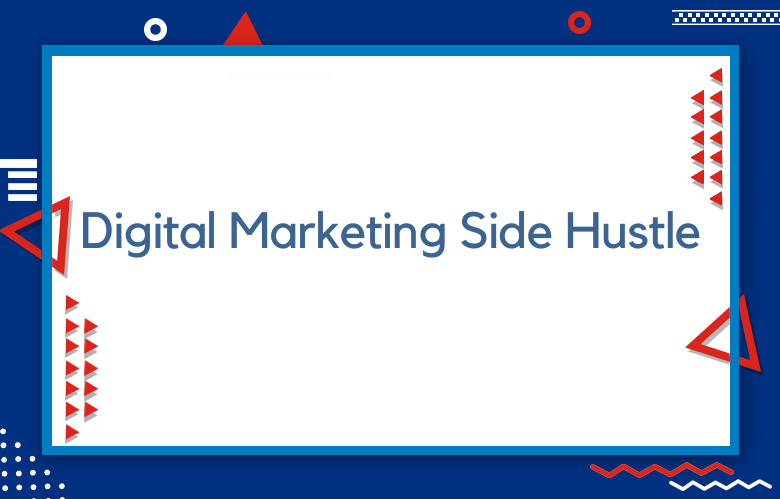Artificial Intelligence Marketing Predictions and Trends

Artificial Intelligence (AI) has disrupted various industries over the past few years, and marketing is no exception. AI can transform how businesses interact with customers and market their products.
AI and machine learning technologies enable marketers to generate insights, automate repetitive tasks, and deliver personalized customer experiences. It delves into some critical artificial intelligence marketing predictions and trends.
Artificial Intelligence Marketing Predictions and Trends
As technology rapidly develops, more industries are beginning to see the benefits of using artificial intelligence. Among these industries is marketing, where AI has proven to be a game-changer.
With its ability to analyze data, provide personalized experiences, and automate processes, AI has transformed how businesses approach marketing strategies. This article will explore the latest AI marketing predictions and trends for 2021.
Predictive Analytics: Leveraging AI for Better Decision-Making
Predictive analytics is an innovative and highly advanced field that harnesses the power of artificial intelligence (AI) to extract insights from massive amounts of data and accurately forecast future outcomes.
This cutting-edge technology transforms decision-making processes across industries, from finance to healthcare, retail to manufacturing.
Through predictive analytics, businesses can better understand customer behavior, gain insights into market trends, and leverage data to optimize operational efficiency and reduce costs.
By analyzing complex data sets with advanced algorithms and machine learning techniques, AI-powered predictive models can provide accurate predictions, enabling businesses to make better-informed decisions.
Video Creation and Production: How AI is Revolutionizing Content Generation
Video Creation and Production is a rapidly growing industry that has seen significant advancements in recent years. With the advent of artificial intelligence (AI), the content generation aspect of the industry has experienced a revolutionary transformation.
Now, it is possible to use AI technology and machine learning algorithms to create high-quality video content, reducing the time and resources required for traditional video production methods.
One of the chief advantages of AI technology in content generation is its ability to understand and manipulate data. It can analyze large datasets and convert the data required into video content or other media formats, resulting in a personalized, engaging, and visually appealing video.
For instance, AI technology has the potential to analyze vast amounts of user data and generate customized content based on individual user preferences, providing an unparalleled level of engagement and perceived relevance.
Hyper-Segmentation: Enhancing Audience Analysis with AI
Hyper-segmentation is a powerful tool that allows marketers and businesses to analyze their audience more deeply and accurately. With artificial intelligence (AI), hyper-segmentation has become even more effective in providing insights into consumer behavior and preferences.
One of the primary benefits of hyper-segmentation is that it allows businesses to identify subgroups within their target audience.
Traditional segmentation techniques may divide a population into broad categories based on demographic factors such as age or gender. However, hyper-segmentation exceeds these essential criteria to uncover more nuanced individual differences.
For example, using AI-powered data analysis, hyper-segmentation can identify patterns in online behaviors that can help businesses better understand customer interests and motivations.
Businesses can cluster customers into subgroups based on shared interests, preferences, and behaviors by analyzing search queries, social media interactions, and website browsing history.
Integrating AI with AR and VR: Transforming the Marketing Experience
As technology advances, businesses must constantly adapt to stay ahead. One way companies are doing this is by integrating artificial intelligence (AI) with augmented reality (AR) and virtual reality (VR) to transform the marketing experience. This integration allows for creating more personalized and engaging customer experiences.
AI can analyze consumer data and anticipate their needs and preferences. This data can then be used to create targeted AR and VR experiences that drive conversions and customer loyalty. For example, a clothing retailer could use AI to analyze a customer’s past purchases and browsing history to create a personalized virtual try-on experience for the customer.
AR and VR also allow for immersive experiences that help customers engage with a brand more meaningfully. For example, a makeup brand could use AR to create a virtual try-on experience that allows customers to see how different products look on their faces in real time.
AI-Driven Advertising: Personalization and Optimization for Better Results
In recent years, the advertising industry has been revolutionized by the development of artificial intelligence (AI) technology. AI-driven advertising techniques have enabled marketers to achieve a higher level of personalization and optimization in their ads, resulting in better results.
One of the critical benefits of AI-driven advertising is the ability to tailor ads to each customer. By analyzing data on a customer’s browsing behavior, past purchases, and other demographic information, AI algorithms can create highly targeted ads that speak directly to that individual’s needs and preferences.
AI-powered advertising platforms can also optimize ad campaigns in real time, allowing marketers to adjust their strategies based on changing trends and customer behavior. This means ads can be fine-tuned for maximum impact, leading to higher engagement and conversions.
Creative AI: Revolutionizing Content Generation and Ownership
Artificial Intelligence (AI) is transforming industries at an unprecedented pace, and creative fields are no exception. With the evolution of Creative AI, content creation, distribution, and ownership are all undergoing a fundamental shift.
Clever AI is a cutting-edge technology that enables computers to generate, compose, and edit content such as music, video, and written materials.
This technology significantly reduces the amount of human input required in the content creation process, creating new possibilities for content production at a scale and pace that were previously unimaginable.
Creative AI has the power to make content creation more efficient and cost-effective. Businesses can save time and money using AI-generated content instead of hiring full-time content creators.
For example, AI-generated product descriptions can significantly streamline the process of uploading and updating large-scale e-commerce websites.
Enhancing Communication with ChatGPT: Benefits and Limitations
Improved Efficiency
ChatGPT (Conversational Generative Pre-trained Transformer) is a new technology enabling businesses to automate customer conversations.
This technology can enhance communication by providing faster and more accurate responses to customer inquiries, thus improving the overall efficiency of customer service operations.
ChatGPT can quickly generate automated responses for frequently asked questions, freeing customer service agents from repeatedly answering the same questions.
Reduced Costs
Using ChatGPT can also help reduce costs associated with customer service operations. Automating conversations with customers eliminates the need for expensive human labor, allowing businesses to save on labor costs while providing excellent customer service.
ChatGPT can help reduce costs associated with training new employees as it requires minimal setup and training time before it can be used effectively.
Increased Accuracy
ChatGPT can also help improve accuracy when responding to customer inquiries. By utilizing natural language processing (NLP) algorithms, ChatGPT can understand the context and intent of each conversation to provide more accurate responses than a human customer service agent can provide.
This improved accuracy helps ensure that customers receive the best possible experience when interacting with a business’s customer service team.
Improved Customer Experience
Using ChatGPT can also improve overall customer experience due to its ability to respond quickly and accurately to customer inquiries.
Customers are often frustrated when they need help answering questions or receiving incorrect information from a customer service representative. Still, this frustration can be avoided by using ChatGPT’s automated conversations, which are always accurate and responsive.
Enhanced Personalization
ChatGPT also allows for enhanced personalization of conversations as it can learn from past interactions to tailor its responses accordingly.
This means that businesses can customize their conversations with customers to provide them with a more personalized experience, which increases satisfaction levels among customers who interact with the business’s customer service team via ChatGPT-enabled services.
Increased Engagement
Automating conversations using ChatGPT allows businesses to engage customers meaningfully without manually dedicating additional resources or personnel.
This increased engagement helps create deeper relationships between businesses and their customers while simultaneously growing loyalty amongst existing customers and attracting new ones through word-of-mouth marketing generated by satisfied users of the business’s services or products who have interacted via automated conversations enabled by ChatGPT technology.
Limitations of AI Technology
Despite all these benefits, there are some limitations associated with using AI technologies such as ChatGPT for automating conversations with customers due primarily to its reliance on NLP algorithms, which may not always accurately interpret complex human language expressions or intentions, resulting in incorrect responses being provided which could lead to dissatisfaction amongst customers who interact via these automated chat services.
AI technologies such as chatbots may only sometimes be able to identify subtle changes in sentiment or emotion within a conversation, making them less effective at providing an appropriate response than a human conversational partner.
Security Concerns
Security concerns associated with using AI technologies such as chatbots to automate conversations are primarily due to their potential vulnerability to malicious attacks that could compromise sensitive data stored within their databases.
Some organizations may view automated chat services as an invasion of privacy since they require access to personal data to function correctly. As such, organizations must ensure that any use of AI technologies, such as chatbots, must comply with relevant security protocols to protect themselves and their customers from potential security risks.
Personalization Powered by AI: Transforming User Experience
Personalization powered by AI is revolutionizing how businesses interact with their customers, transforming user experience like never before.
With advancements in AI technology, companies can analyze vast amounts of data and leverage machine learning to provide personalized recommendations and experiences for each user.
One key advantage of AI-powered personalization is accurately predicting user behavior. By analyzing a user’s past behavior and preferences, AI algorithms can anticipate their next move and tailor recommendations accordingly.
This leads to a more seamless and intuitive user experience, as users are presented with content and actions that are highly relevant to their needs and interests.
Another advantage of AI personalization is increased efficiency and scalability. Traditional personalization methods often rely on manual processes or limited data sets, which can be time-consuming and expensive to scale.
AI-powered personalization removes these limitations by automating the data analysis and personalization process. This allows businesses to provide a personalized experience to more users without sacrificing accuracy or quality.
Forecasting the Future: Key Trends Shaping the AI Market
Increased Use of AI in Business
Artificial intelligence (AI) in business is expected to increase significantly over the next few years. AI can automate mundane tasks like data entry and customer service, freeing employees’ time for more meaningful work. AI can help businesses make better decisions by providing insights into customer behavior and trends.
Growing Adoption of Machine Learning
Machine learning is a type of AI that allows computers to learn from data without being explicitly programmed. As machine learning algorithms become more advanced, they will be increasingly adopted by businesses looking to gain a competitive edge. Machine learning can be used for various purposes, such as predicting customer behavior or optimizing marketing campaigns.
Rise of Edge Computing
Edge computing is distributed computing that brings computation and data storage closer to the user or device rather than relying on centralized servers located far away.
This technology is becoming increasingly important as more devices are connected to the internet and must process data quickly without relying on remote servers. Edge computing will enable faster response times and improved performance for AI-powered applications.
Expansion of Voice Assistants
Voice assistants are becoming increasingly popular. They allow users to interact with their devices using natural language instead of typing commands into a keyboard or touchscreen interface.
Voice assistants are powered by AI technologies such as natural language processing (NLP) and speech recognition, making them more accurate and responsive with each passing day.
Emergence of Autonomous Vehicles
Autonomous vehicles are expected to revolutionize the transportation industry in the coming years as they become increasingly capable and reliable due to advances in AI technologies such as computer vision and deep learning algorithms.
Autonomous vehicles will offer numerous benefits over traditional cars, including increased safety, reduced emissions, lower costs, and improved convenience for passengers and drivers alike.
Proliferation of Smart Devices
Smart devices such as TVs, refrigerators, speakers, thermostats, security systems, etc., are becoming ubiquitous in homes worldwide thanks to advances in AI technologies like computer vision and natural language processing (NLP).
These devices allow users to control their environment with voice commands or gestures instead of manually pressing buttons or flipping switches on traditional appliances or systems.
Development of Chatbots
Chatbots are computer programs that use natural language processing (NLP) algorithms to simulate human conversation via text or voice chat interfaces.
They have become increasingly popular over the last few years due to their ability to provide quick customer service at scale with minimal human intervention.
Chatbots are expected to continue gaining traction over the next few years as developers create more sophisticated algorithms that can easily handle complex queries.
Growth in Robotics Applications
Robotics is another area where advancements in AI technologies have enabled significant progress over recent years. Robots powered by AI algorithms can now perform tasks ranging from simple pick-and-place operations up complex assembly lines, making them invaluable tools for many industries around the world. As robots become more innovative, faster, and cheaper, their adoption rate will grow significantly over the coming years.
Preparing for the AI Revolution: Opportunities and Challenges
Developing AI Infrastructure
The first step in preparing for the AI revolution is to develop the necessary infrastructure. This includes investing in high-speed internet, cloud computing, and data storage solutions that can support the development of AI applications.
It also includes building AI-specific hardware, such as GPUs and TPUs, to enable faster and more efficient data processing. Governments should invest in developing their own AI research centers and funding initiatives to help drive innovation in the industry.
Educating the Workforce
The second step is ensuring workers have the skills to work with emerging technologies. This means providing training and educational opportunities for people looking to transition into an AI-related field or update their skills.
Companies should also consider partnering with universities and other organizations to offer specialized courses tailored to specific areas of AI development, such as machine learning or natural language processing.
Creating an Ethical Framework
The third step is to create an ethical framework for using AI technology. This includes setting guidelines on how companies can use data responsibly and ethically and ensuring that algorithms are not biased against certain groups of people or used for malicious purposes.
It also involves creating policies regarding privacy and security to protect users’ personal information from misuse or exploitation by companies or governments.
Establishing Regulations
The fourth step is to establish regulations around the use of AI technology, particularly regarding autonomous systems such as self-driving cars or drones.
Governments should set clear rules regarding what types of autonomous systems are allowed on public roads or airspace and establish safety protocols to protect people from accidents or malfunctions caused by faulty programming or hardware failures.
Incorporating Human Oversight
The fifth step is to incorporate human oversight into any decision made by an autonomous system, whether it be a car driving itself down a highway or a robot performing surgery on a patient in a hospital setting.
This could involve implementing fail-safe measures so that humans can intervene if an autonomous system makes a potentially dangerous decision, as well as having humans review any decisions made by an independent system before implementation to ensure accuracy and fairness across all scenarios.
Investing in Research and Development
The sixth step is investing in research and development related to artificial intelligence technologies such as machine learning, natural language processing, computer vision, robotics, etc.,
This will be essential for advancing the capabilities of these systems over time and ensuring they remain safe and reliable for use in various applications ranging from healthcare to transportation and beyond.
Governments should also provide incentives for private companies looking into developing new technologies related to artificial intelligence so that these innovations can be brought into the real world sooner rather than later.
Addressing Potential Job Losses
The seventh step addresses potential job losses due to automation caused by adopting artificial intelligence technology across various industries such as manufacturing, transportation, retail, etc.
Governments must create policies that assist those who may lose their jobs due to automation while encouraging retraining programs so workers can transition into new roles within their respective industries.
Governments should encourage businesses to invest in upskilling existing employees instead of replacing them with machines whenever possible.
Exploring New Opportunities
The eighth step is exploring new opportunities created by adopting artificial intelligence technology across various sectors such as healthcare, finance, education, etc.
For instance, healthcare providers can leverage machine learning algorithms combined with medical imaging techniques like X-rays & CT scans, helping diagnose diseases much faster than traditional methods.
Similarly, financial institutions can utilize automated trading algorithms and predictive analytics models, which enable them to make better investment decisions and increase profitability.
Educational institutions can leverage natural language processing & computer vision technologies, allowing students access to personalized learning materials tailored to their needs.
Conclusion
AI has the potential to transform marketing as we know it. AI-powered Marketing tools can offer tangible benefits, including increased efficiency, personalization, targeting, improved ROI, and better customer experiences.
Thus, businesses can position themselves to thrive by implementing these AI Marketing trends. By embracing AI, companies can benefit from its undisputed advantages in the marketing space.
In conclusion, the growth of AI in marketing is set to accelerate, with businesses that don’t adopt this technology likely to be left behind. Chatbots, voice assistants, automation, predictive analytics, and personalized content are all AI trends that will continue to develop in 2021 and beyond.
Businesses that utilize these trends to their advantage will be able to improve their marketing strategies, resulting in increased customer engagement and retention rates and, ultimately, business growth.
Call: +91 9848321284
Email: [email protected]



